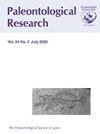日本仙台Moniwa组新中新世Phidoloporid(Bryozoa,Cheiloporta)
IF 0.6
4区 地球科学
Q3 PALEONTOLOGY
引用次数: 0
摘要
摘要从日本仙台市赤石桥附近的Moniwa组(Langhian)采集到一种新的中新世phidoloporid,即碘虫。这是日本第一个碘虫属化石记录,也是印度-太平洋地区第五次发现碘虫属中新世化石。该物种类似于西太平洋的一些新近物种,尤其是在大的边缘孔隙、开放的骨周窦和骨轴以及亚三角形的特殊唇瓣中。比较了始新世至近代碘虫属的特征,推断了碘虫属植物的进化趋势。本文章由计算机程序翻译,如有差异,请以英文原文为准。
Iodictyum akaishiensis sp. nov.: A New Miocene Phidoloporid (Bryozoa, Cheilostomata) from the Moniwa Formation, Sendai, Japan
Abstract. A new Miocene phidoloporid, Iodictyum akaishiensis sp. nov., was collected from the Moniwa Formation (Langhian) near the Akaishi Bridge, Sendai City, Japan. It is the first fossil record of Iodictyum in Japan, and the fifth discovery of Miocene fossils of the genus from the Indo-Pacific area. The species resembles some Recent species from the western Pacific, especially in the large marginal pores, an open peristomial sinus and shaft, and subtriangular ooecial labellum. The characteristics of Iodictyum from Eocene to Recent are compared, and the trend of evolution in the genus is inferred.
求助全文
通过发布文献求助,成功后即可免费获取论文全文。
去求助
来源期刊

Paleontological Research
PALEONTOLOGY-
CiteScore
1.60
自引率
0.00%
发文量
47
审稿时长
>12 weeks
期刊介绍:
Paleonotological Research (PR) is a quarterly, peer-reviewed international journal, which focuses on original contributions primarily in the area of paleontology but also covering a wide range of allied sciences. It has been published since 1997 as a successor to the former journal Transactions and Proceedings of the Palaeontological Society of Japan. The emphasis of contributions will include global and local perspectives, and contents can cover all ages (Precambrian to the Quaternary, including the present time).
 求助内容:
求助内容: 应助结果提醒方式:
应助结果提醒方式:


